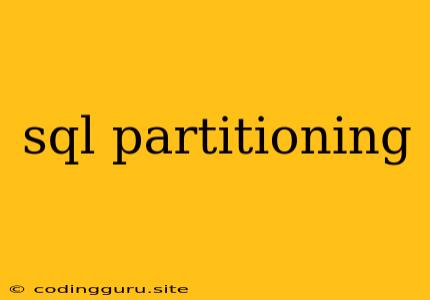SQL Partitioning: Optimizing Database Performance for Large Tables
Have you ever encountered a database query that takes an excruciatingly long time to execute, leaving you frustrated and your application sluggish? One of the culprits behind this sluggishness could be the sheer size of your database tables. As tables grow larger, they can strain database performance, leading to slow queries, longer response times, and an overall negative user experience. Enter SQL partitioning, a powerful technique that can significantly enhance performance and optimize your database management.
What is SQL Partitioning?
SQL partitioning is a technique that divides a large database table into smaller, more manageable chunks called partitions. These partitions are organized based on specific criteria, such as a date range, customer ID, or any other relevant column. This strategic division allows the database to focus on only the relevant data during queries, making operations significantly faster.
Imagine you have a massive table storing sales records for an e-commerce platform. This table might contain millions of entries, making it challenging to retrieve specific sales information quickly. By partitioning the table based on the date of sale, you can effectively group the data into separate partitions for each month or year. When you query for sales data from a specific period, the database only needs to access the relevant partition, greatly reducing the amount of data processed.
Why Use SQL Partitioning?
SQL partitioning offers numerous benefits, making it a valuable tool for managing large datasets:
- Improved Query Performance: By narrowing down the search to specific partitions, queries execute much faster.
- Reduced Disk I/O: Accessing fewer data blocks translates to lower I/O operations, resulting in faster data retrieval.
- Enhanced Data Management: Partitioning allows for more efficient data maintenance tasks like backup, restore, and deletion.
- Optimized Data Analysis: Separating data by specific criteria enables quicker and more focused data analysis.
- Improved Scalability: SQL partitioning helps manage large volumes of data, making your database more scalable.
Types of SQL Partitioning
SQL partitioning comes in different flavors, each offering unique advantages:
- Range Partitioning: Divides a table into partitions based on a range of values in a column. For instance, a table containing sales data could be partitioned into separate ranges for different years.
- List Partitioning: Splits a table into partitions based on distinct values within a column. This is helpful for scenarios where you have discrete categories like customer types or product categories.
- Hash Partitioning: Uses a hash function to distribute data across partitions. This is particularly useful when you need to distribute data evenly across multiple partitions.
- Composite Partitioning: Combines multiple partitioning strategies to achieve more granular data segmentation.
How to Implement SQL Partitioning
Implementing SQL partitioning involves a few key steps:
- Define the Partitioning Strategy: Determine the partitioning criteria based on your specific data and query needs. Consider factors like data volume, query patterns, and data access requirements.
- Create the Partitions: Utilize SQL commands to create the partitions based on your chosen strategy. The syntax for creating partitions varies slightly depending on the database system.
- Maintain Partitions: Regularly maintain the partitions to ensure optimal performance. This includes adding new partitions as data grows and managing existing partitions as needed.
Real-World Examples of SQL Partitioning
SQL partitioning finds wide application in various scenarios:
- E-commerce: Partitioning sales data by date allows efficient analysis of sales trends over different periods.
- Financial Institutions: Partitioning transactions by account type or time period helps analyze financial activity quickly.
- Healthcare: Partitioning patient records by medical conditions or treatment dates facilitates efficient data retrieval for research and analysis.
Considerations and Best Practices
While SQL partitioning offers numerous benefits, there are some considerations and best practices to keep in mind:
- Choose the Right Partitioning Strategy: Carefully select a partitioning strategy that aligns with your data and query requirements.
- Balance Partition Size: Aim for reasonably sized partitions to optimize performance without excessive fragmentation.
- Optimize Data Access: Ensure your queries are optimized to take advantage of partitioning.
- Manage Partition Growth: Plan for regular maintenance to add new partitions as data grows.
Conclusion
SQL partitioning is a powerful technique for optimizing database performance, especially when dealing with large tables. By strategically dividing tables into smaller, more manageable partitions, you can improve query speed, reduce I/O operations, and enhance overall database efficiency. By carefully considering the various types of partitioning and applying best practices, you can effectively leverage this technique to ensure your database operates smoothly and delivers fast performance.
